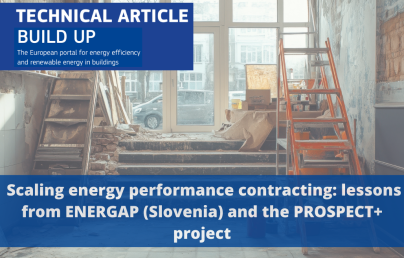
Overview Article - Space cooling technologies for buildings: Alternative solutions to conventional applications

Overview Article - Space cooling technologies for buildings: Alternative solutions to conventional applications
With longer and more frequent heat waves, the demand for space cooling is dramatically increasing globally. How can we make cooling systems more sustainable?
Authors:
- Clémence Contant, Project Manager at REVOLVE - LinkedIn
- Simon Pezzutto, Senior Researcher at Institute for Renewable Energy - Eurac Research - LinkedIn
- Ciara Kristensen, Junior Communication Officer at REVOLVE - LinkedIn
Introduction
Almost 99% of Europe’s space cooling consumption is currently comprised of vapour compression systems. With summer heat waves rising in frequency and intensity, the energy consumption from space cooling is drastically increasing every year. Many less energy-intensive technologies are available on the market but are unknown by consumers for a variety of reasons. Improving transparency and raising awareness among consumers and end-users about the use of these technologies is one of Europe’s challenges in reaching EU Green Deal goals by 2050.
This article is an overview of what the market can offer today.
How is space cooling important in our daily lives?
With the effects of climate change continuing to break historical record temperatures around the world, space cooling in our public and private spaces is now a necessity for almost all countries in Europe each summer. According to the International Energy Agency the energy demand for space cooling is set to triple by 2050 if we do not address energy efficiency.
Space cooling is defined as the amount of heat that needs to be removed from indoor air to cool the space in order to ensure the thermal comfort of the occupants of enclosed areas. Space cooling applications can be found in different sectors, mainly in the tertiary (such as offices, trade, education, health, restaurants, and hotels) and residential (single-dwelling and multi-dwelling houses and apartment) building sectors.
Without adequate design improvements, the increasing use of energy for space cooling paves the way for further inflated energy costs, lack of access to space cooling for those in warm and hot climates who need it the most (and also for those living in milder climate, but in recent buildings conceived only for minimising winter loads), and subsequent negative impacts on human health.
Alternative space cooling solutions and good practices
Two kinds of space cooling technologies are available on the market:
- Active: technologies requiring external energy (such as air conditioning systems)
- Passive: the use of the building’s design and materials in order to keep a comfortable indoor temperature without the use of mechanical or electrical devices (such as blinds, building insulation, green roofs, and blinds).
The use of active vapour compression technologies represents almost 99% of the final energy consumption for space cooling in the European market (including the United Kingdom). The remaining 1% is mainly covered by thermally driven heat pumps (including also solar power and geothermally driven heat pumps). They offer different advantages and benefits, depending on technical parameters, market maturity, costs, and utilisation adapted accordingly by sector (1).
Figure 1 presents a wide variety of space cooling technologies. Certainly, having higher efficiency and lower costs than vapour compression systems could make these alternative space cooling technologies competitive and preferable options to vapour compression. However, having a different level of development and readiness (according to the Technology Readiness Level scale, TRL), means that not all technologies currently present a viable alternative.

Figure 1. List of the identified cooling technologies. Source: S. Pezzutto, et al.; Screening of Cooling Technologies in Europe: Alternatives to Vapour Compression and Possible Market Developments, Sustainability Journal, 2020. Available here.
More efficient air conditioners currently available can cut carbon emissions from space cooling in half, and when combined with cleaner power sources, can radically reduce overall emissions. Local air pollution can also be drastically reduced.
Specific alternative solutions and recommendations exist, such as combining thermally driven heat pumps with solar thermal systems (solar cooling systems) as well as reversible ground source heat pumps (GSHPs). GSHPs are niche but can be very competitive in certain contexts. However, this comes with a number of potential limitations, including higher installation, operation, and maintenance costs, and space constraints associated with rooftop installation.
Furthermore, indirect ambient air-free cooling, use of liquid with natural or waste cold source, evaporative cooling, direct, indirect, direct plus indirect, and cold storage (centralised) are all more efficient than vapour compression systems. Moreover, passive solutions (e.g. solar shading) and district cooling (DC) systems proved to be effective and cost-efficient measures. In particular district cooling systems, which take advantage of free cooling, such as lakes, rivers, etc., result in being better low-carbon solutions as they can exploit renewable energy sources and excess energy from anthropic processes. Furthermore, taking advantage of thermal energy storage, they can meet peak cooling demand and make the electricity grid more flexible (2).
EU funding to develop efficient and renewable alternatives
While the EU’s heating sector is broadly explored in scientific literature, there is a significant lack of data and information in the space cooling sector. In 2021, the European Commission published the Delegated Act establishing a methodology for calculating the quantity of renewable cooling and district cooling that can be counted towards EU renewable energy targets. This methodology is the first such calculation method that has been introduced anywhere in the world. It rewards the best available technologies of today, such as highly efficient reversible heat pumps and free cooling by district cooling networks. The idea is to push the research and development for innovative cooling technologies, such as solar cooling, that both reduces energy consumption and increases the use of renewable sources for cooling.
In June 2022 revisions of the 2021 were published, proposing different analyses and methodologies of calculations for renewable cooling solutions.
In this context, several projects are funded to develop tools and raise awareness about the alternatives for cooling technologies:
- The CoolLIFE project began in 2022 and aims to address the need for sustainable solutions to the EU’s rising demand for space cooling in buildings, promoting innovative space cooling technologies and the use of available local renewable energy supply. By 2024, the project will develop open-source tools encouraging the consideration of sustainable space cooling solutions in public and private decision-making, planning, design, and implementation processes. Read more.

Figure 2. CoolLIFE Analyse tool. Source: CoolLIFE project
- The COOLING DOWN project, which also started in 2022, aims to strategically develop renewable cooling in Europe, while also developing policy recommendations and proposals to achieve it. It also aims to address the contribution of renewable cooling technologies such as geothermal and solar thermal sources. Website.
- The H2020 CO-COOL project, which started in 2021, aims at accelerating the cooling technology development and deployment. Specifically, based on the innovation of composite solids (sorbents/PCMs) and fluids (PCMs and hydrate slurries) and related components and systems, the goal is to develop renewable/recoverable energy driven, storage-integrated cooling technologies which can offer efficient and cost-effective solutions for end users´ needs. Website.
- HACKS project (Heating and Cooling Knowhow and Solutions) ended in February 2023, worked to enable the market transformation for heating and cooling (HAC) appliances and improving the comfort and health of European citizens. In particular, the project developed awareness campaigns to raise awareness on the economic and environmental benefits bought by HAC products and solutions. Apart from engaging with households, the project also engaged with relevant stakeholders of the decision-making process of consumers on setting up a strategic partnership to facilitate the purchase of energy efficient appliances. Website.
- INDIGO project aimed to support the development of a more efficient, intelligent and cheaper generation of DC systems by improving system planning, control and management, through the development of two open-source tools: (i) a planning tool for DC systems with the aim of supporting their optimal design; (ii) a library with thermo-fluid dynamic models of DC System components which to provide the designers detailed information about their physical behaviour. Website.
- COOLTORISE project aims at raising summer energy poverty awareness to reduce cooling needs. The project will pilot measures to reduce the impact of heatwaves in low efficient households and deliver tools and information both to households and stakeholders to ensure families can afford to keep their homes adequately cool during heatwaves. Website.
Conclusion
Ultimately, there are no alternative space cooling technologies characterised by higher efficiency and lower costs than traditional vapour compression technologies on the EU market today. Thus, such technologies result in being less competitive compared to conventional space cooling equipment. In addition to the need for research and development to advance the TRL of alternative sustainable technologies, the availability of open information regarding the technical and economic aspects of such technologies is lacking.
Although the membrane heat pump, trans critical cycle, Reverse Brayton (Bell Coleman cycle), and absorption cooling technologies have all been appointed as promising solutions to compete with vapour compression, they are at varying stages of readiness to be deployed on the market and there is a significant lack of information regarding their potential cost and efficiency benefits. With the need for alternative solutions continuing to grow, it is more important than ever to provide consumers with accurate and comprehensive resources to ensure a sustainable future in space cooling.
Do you have more insights or more examples of innovating solutions? Share it with the BUILD UP community.

